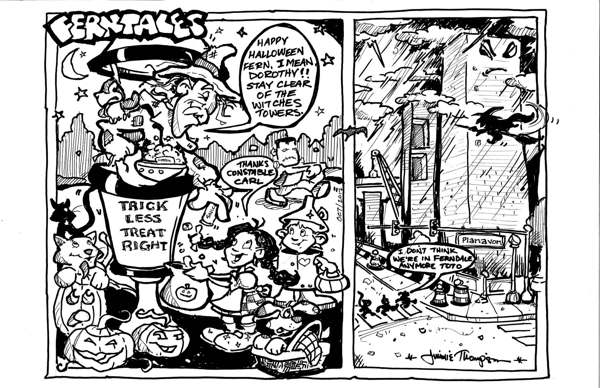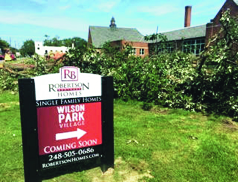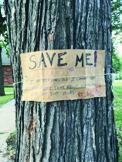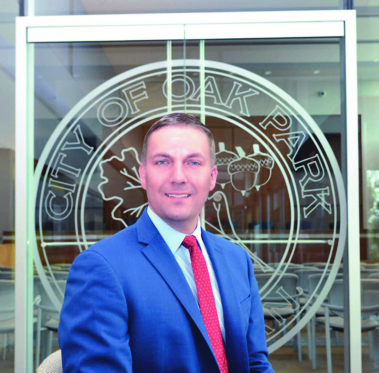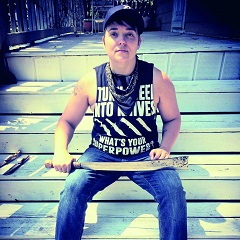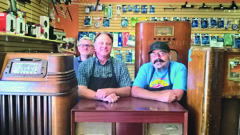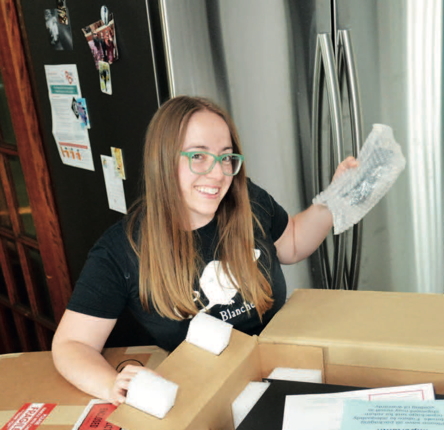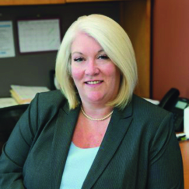Loving – & Not Love the New Housing Projects
By: Sara E. Teller
ROBERTSON BROTHERS IS A FAMILY-OWNED COMPANY IN BUSINESS for over 70 years, providing housing mainly in Oakland and Wayne Counties. Some notable projects include Lexington on the Park, Sherman Oaks and Normandy Oaks in Royal Oak.
As of late, the company has been busy completing two new home sites in Ferndale at the former Wilson  Elementary School and Taft Digital Learning Center locations. “Organizationally, we’re very excited,” said Tim Loughrin, Manager of Land Acquisition. “We’re happy to be in Ferndale.”
Elementary School and Taft Digital Learning Center locations. “Organizationally, we’re very excited,” said Tim Loughrin, Manager of Land Acquisition. “We’re happy to be in Ferndale.”
The Wilson site is a little further along, abatement beginning roughly a month ago, followed by demolition. “Trees have been cleared. Contractors [have] moved in,” Loughrin said. “Grading and installing the underground utilities, including water, sewer and storm, will follow the demo, and paving is scheduled to begin sometime in November.”
Twenty-eight single-family homes will be constructed at the site of the former Wilson Elementary school. There will be four options in total: two main floor plans, with an additional two variations of those. The homes, ranging from 2,100 to 2,400 square feet, will be built to order. Homeowners will be able to select a lot, home plan and color scheme, as well as their finishes starting in November. There hasn’t been a new project for single-family homes in the area for 50 years,” Loughrin said. “That’s what excited me the most about this project.”
The Taft site is a new concept for the area. “We’re providing options that don’t exist in the current market. I like to call it the ‘missing middle’,” Tim explained. This is essentially offering an option somewhere between a hi-rise and a single-family home. “Townhomes with medium density don’t exist,” Loughrin said. “We’ve been successful with offering this in other markets.”
Taft will consist of 72 one-to-two car garage townhomes ranging from 1200 to 1500 square feet. Two or three-bedroom options will be avail-able, and homeowners will be able to select their finishes within 30 days of purchasing their new home. All finishes will be available at the Robert-son Brothers design center located at their main office building in Bloomfield Hills.
Because of the new concept at Taft the approvals took a bit longer than expected, but the project is only slightly behind Wilson’s schedule.
Demolition is scheduled for mid-October, which will be followed by grading and installing the underground utilities. “Unfortunately, paving won’t likely happen until next year,” Loughrin said. The asphalt plants will close down in late Fall, reopening sometime in April or May. He is hopeful they will be able to complete a model in the meantime, however.
Subcontractors have placed bids on both projects, and Robertson’s project managers are busy overseeing work. According to Loughrin, the community was heavily involved in the planning phase as the company engaged in neighborhood meetings to ensure they were offering new home options needed in the Ferndale area. “The community is aware of what we’re doing.” Loughrin said.
Justin Lyons, Planner at the City of Ferndale, said, “These will be a big benefit to schools. The sites were a bit of a burden to the community, with the buildings deteriorating. The development partner came up with a plan to alleviate this burden.” He adds that the new sites were “part of a master plan adopted earlier this year regarding the major theme and goals, including providing more types of housing and housing options.” Through a public participation process, the City tried to determine what residents want, and new stock was an issue that came up time and again. “This’ll be a great option for families or anyone who is looking to move to Ferndale,” he said.
NOT EVERYONE IS SO ENTHUSED. David Lungu of The Ferndale Historical Society went to Wilson Elementary as a child. He lived one block from the school for a number of years. “I am 52, and have been a resident of Ferndale almost all my life,” he said, having moved to Southfield just a few years ago.
He has been a board member of the Historical Society for 25 years. As far as the new housing project, David 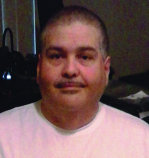 said, “I am really not in favor…because we will lose valuable green space. I remember watching commission meetings where they said they will not get rid of green space. I guess times change,” he sighed. “I do think if they had just replaced the existing footprint of the school with new housing and kept the rest green it would be okay, since buildings were already there.” Ferndale will always be special to David.
said, “I am really not in favor…because we will lose valuable green space. I remember watching commission meetings where they said they will not get rid of green space. I guess times change,” he sighed. “I do think if they had just replaced the existing footprint of the school with new housing and kept the rest green it would be okay, since buildings were already there.” Ferndale will always be special to David.
“My favorite thing about Ferndale is the friendly and nice atmosphere. I felt real safe and still do when I visit now. For over 45 years I lived in Ferndale, went to Wilson school, then to the old Coolidge Jr. High, then to Ferndale High School where I graduated in 1983.” He recalled many fond memories of attending Wilson Elementary School and baseball games at Wilson Park.
SO, THERE HAS BEEN A MIXED REACTION to the two builds, consisting of either enthusiasm or a sort of nostalgic regret. The area is losing a couple of valuable historic monuments, but the new housing will no doubt attract new residents and boost commerce.
Who Will Save Our Trees
By : Jon Szerlag
TO MAKE CHANGE, YOU DON’T ALWAYS HAVE TO SEE IMMEDIATE RESULTS. Sometimes it’s opening peoples’ eyes and minds to a thought, an idea. That is what one local Ferndale resident did when she went for a walk one day in late August near the Wilson Park.
As construction at the site of the former Taft School began (see adjoining article), Shannon O’Brien, a resident 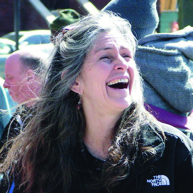 of Ferndale for about 25 years and Ferndale Friends Circulation Manager, noticed trees that were marked to be cut down. Already feeling a little disheartened, she remembered taking her son when he was younger to the park, and how he would sit under the trees for shade.
of Ferndale for about 25 years and Ferndale Friends Circulation Manager, noticed trees that were marked to be cut down. Already feeling a little disheartened, she remembered taking her son when he was younger to the park, and how he would sit under the trees for shade.
Piece by piece (trees and nature) are disappearing,” O’Brien said. “When my son was in kindergarten, we would go to this park and it was great. I never thought about it at that time.”
While the city landscape has changed, O’Brien said cutting down these old trees which have stood for more than 100 years, and a philosophy of developing every inch of space, is not characteristic of the Ferndale she loves.
O’BRIEN WENT HOME WANTING TO DO SOMETHING to try and save the trees. Then she had an idea: She looked around for something to write on but all she could find was a brown paper bag. She made a quick sign that simply read, “SAVE ME! I am 150+ years old. I cannot be replaced. Please think about my bottom line, not just yours.” Then she marched down to the park and hung it on one of the trees.
Not thinking her brown paper bag sign would have much of an impact, she was surprised to find that within several days signatures started to show up on her sign, which stayed tied to the tree on the south side of the former campus. Before she knew it, there were more than 50 signatures on her sign, and the brown square with her words printed on it stayed until it was one of the last few trees standing.
While the trees were not spared, O’Brien’s spirits were lifted not only by the people who signed her statement, but also stepped up to try to save other trees throughout the city of Ferndale as others began posting similar signs. And her tiny campaign sparked a minor fury around town on social media, and led to articles in Oakland County Times and an interview with Channel 7 WXYZ News.
When she went to where the tree once stood, after work as a caregiver, the tree was now only a stump. O’Brien went and counted the rings. 127 in total.
O’Brien does not know what will happen next, but her love for trees and finding a balance between development and preserving the rich and old natural habitat of the city will continue to be on her mind. She has reach-ed out to the developer and city officials, and if she can find others to help her she may start reaching out more in a grassroots effort.
While development, growth and progression will most likely continue in our city and others, O’Brien is becoming more hopeful that developers and City officials will be more conscious of the area’s natural habitat.
“My son said to me, ‘Do one thing different, and it will make a change,’” O’Brien said. “One small thing can make a difference: ask questions, ask for support or join an organization. I want to bring more consciousness and am thinking of reaching out to different organizations like the Historical Society to see if there is interest (in preserving nature in the city.
O’Brien is not discouraged by the trees at the park being cut down. The community’s input, signatures and surprising kindness has given her hope for Ferndale, and the surrounding area’s natural beauty and heritage.
“One of my friends said she loves what I am doing, and how I am doing it in a peaceful way,” O’Brien said.
“Where there is a will there is a way.”
Oak Park’s City Manager Erik Tungate is Leading Change in Metro Detroit
STORY BY: Sara E. Teller
Photo By: Bernie LaFramboise
OAK PARK CITY MANAGER ERIK TUNGATE ALWAYS WANTED HIS CAREER to be about more than just titles and financial rewards. “Money has never been a motivating factor for me; people are,” he explains. “I wanted to have a career that focused on improving people’s lives. Human beings come first, and consideration for their safety and general welfare is always my top priority. We – myself, my staff and our public safety officers – all share the same position.”
Originally from Southwestern Michigan near Kalamazoo, he relocated to Detroit in 1999. “At the time, I didn’t know anyone here,” he said. “But it was the best decision I ever made.” His areas of expertise include community and economic development at the state level with the Michigan Economic Development Corporation, and strong financial management as a Senior Financial Credit Analyst in the banking industry, as well as positions within local, county, and state levels of government. Prior to accepting the position of Oak Park City Manager in 2012, he held the same role in Hamtramck.
Tungate was attracted to Oak Park, because he sincerely believes “…the potential for dramatic improvement in this city is tremendous. Oak Park is a new frontier for economic development. On top of that we have the ability to provide superior public amenities in a culture of excellence. Oak Park was a diamond in the rough when I came here. I was shocked by the incredible opportunity that lies within this community.”
Shortly after his arrival in Oak Park, he made a few departmental additions. “We instituted a Human Resources Department and an economic development function back then,” he explains, adding, “You know, when cities are financially struggling, the natural reaction is to bunker down. Finding cost-efficiencies in every nook and cranny should always be a part of the operation, but I believe you also need to deploy a plan to grow the tax base. And you do this through building an economic development machine like the one we now have in Oak Park.”
Under Tungate’s leadership, FedEx Ground also decided to open a distribution center in Oak Park, the largest land deal in the city’s history. “There was so much vacant land where the old armory once stood. The shipping company was attracted to Oak Park’s easy access to freeways and proximity to major transportation thoroughfares,” Tungate said. “The city also has the ability to attract and meet the housing demand of new employees with its affordable housing stock. This one development alone increased jobs, spurred small business development (trucking contractors), and helped us grow our tax base.”
Although he believes Oak Park has already changed dramatically, there is one thing Tungate would like to see: The push for more mixed-use development. Tungate credits the hard work of Economic Development and Communications Director Kimberly Marrone whom he hired in 2014, for the growth the city has seen in this area over the last few years with the Jefferson Oaks redevelopment and Coolidge Place projects among others. He adds, “Millennials and seniors are being priced out of housing in other suburbs and in parts of the City of Detroit. Oak Park is still able to provide great, affordable housing opportunities. Oak Park has taken a front row seat in pushing for these kinds of developments.”
Not only is Tungate invested in Oak Park, but he holds high hopes for the Detroit region, “Having the cross-state familiarity that I do, and with the economic climate that we now face, it’s what motivates me and makes me want to get the entire state of Michigan running on all cylinders. There’s a formula we have to find to bring our unique interests together for the welfare of all of us. Unfortunately, right now there’s too much division.” Working with other communities on projects or to make change promotes the regionalism in the area and allows the entire region to prosper.
Tungate realizes the value in connecting with Oak Park’s other adjoining communities. Speaking specifically of the Nine Mile Redesign, which Tungate credits Ferndale for starting the trend, he says it offers an excellent opportunity to create an interconnectedness. “Working with our friends in Ferndale, who led the charge with their own redesign, we’ve been able to plan for wonderful public amenities in our own plan. We’re an inner ring suburb that borders Detroit, so we have unique population density. Creating pocket parks and providing bike trails with tremendous amenities is what Oak Park should be looking at doing.”
He says that rather than secluding the city from the other side of 8 Mile Rd., there has been a push to open it up. “Turning away from our southern border with Detroit would be a tremendous mistake. Let’s open the door to all of the possibilities a strong partnership with Detroit can provide.”
With this in mind, new restaurant owners are able to secure a liquor license in the once-dry city. This new economic development tool that enables new restaurants to secure a Class “C” liquor license for under $2,000 helped us to attract a new destination restaurant, “8MK.” “8MK” is a restaurant currently under development by the Union Joints Restaurant Group which also owns The Clarkston Union, Union General, Union Woodshop, Woodshop Shop, Vinsetta Garage, Fenton Fire Hall, Pumphouse and Honcho. “When the opportunity for 8MK came to us, we pounced on it for two reasons – we were able to preserve a historic building, and it helped open us up to 8 Mile Rd.” 8MK occupies space once held by the WWJ transmitter building and 8MK is a reference to the station’s original call letters.
Tungate is focused on maintaining the city’s diversity. “Oak Park is the eighth-most diverse city in Michigan, and it is a perfect example of a diverse community that gets along and works together. What I would like to see is us continuing to attract new residents who appreciate what we have to offer.
As for future endeavors, he notes, “We will be unveiling some very important development projects soon. As we continue to build the city’s pipeline, we’re attracting quality retailers and restaurants, both locally-owned and national retail chains.”
Rachel Oliver : Fire and Pride
By Kevin Alan Lamb
OUR WORLD IS RETRACING roots and rediscovering a passion for trades our parents, and grandparents spent lifetimes mastering. Simultaneously, society is relearning to see an individual for the goodness in their heart, joy in their dreams, and the consistency of their contributions. We all have a purpose, but we must travel a personal journey dictated by our choices and commitments to discover the substance with which we will fill our souls.
Rachel Oliver navigated her journey with the help of the skills and life lessons she learned in her father’s shadow. In each of his children he instilled the understanding that gender was not an excuse or limitation on one’s ability to persevere.
Raised between Taylor and Carleton, Michigan, Oliver was recently launched into the limelight with a once-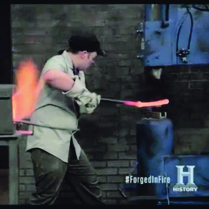 in-a-lifetime opportunity to be a participant on History Channel’s fourth season of ‘Forged in Fire.’ Critiqued by world-renowned bladesmiths, she competed against expert bladesmiths and blacksmiths, filming for 10-15 hours day on set where she won second place.
in-a-lifetime opportunity to be a participant on History Channel’s fourth season of ‘Forged in Fire.’ Critiqued by world-renowned bladesmiths, she competed against expert bladesmiths and blacksmiths, filming for 10-15 hours day on set where she won second place.
Can you walk our readers through your average day on set of “Forged in Fire?”
The day starts before the day on set. It starts with a ride through New York City, en route to the Brooklyn forge. Taking it all in was surreal, from cars driving in reverse on one-ways to peddlers on street corners selling food and wares.
Once you arrive at the set, you are in for a long, long haul, consisting of 12- to 15-hour days, and several interviews. There is lots of downtime, which is the coolest part. This is where you get to mingle with the competitors and talk shop, trade secrets, methods and history of many things. The judges are all there, the host is there, and they all come chat.
We didn’t forge until late after-noon. We came into the forge for the first time, it’s secretive until we enter the floor. We are not privy to any of the layout until it’s time to compete. When you walk into the forge, it’s like entering battle-grounds, a coliseum if you will.
When the host says “go,” it’s hammer time and that clock does not stop for anything. Bathroom breaks? Nope [laughter]. Luckily, floor hands take care of our hydration needs. Hydration is the word you hear more on set than anything else. We get so amped up we forget about our own well-being. The entire time you’re on the floor there are upwards of 50 people, the judges included, all over the place. You have camera guys following you around, big Hollywood lights, an OSHA guy is on set, I mean it’s a huge operation.
What are some key takeaways and moments you will never forget?
I was given the chance to work in an arena that blacksmiths I revere have also competed in. I got to work with three great guys: a youth minister, a blacksmith who’s been at it 28 years, and a blade smith with skills that blow my mind. The blade smith, Shawn, was kind enough to sip scotch with me after hours drawing up diagrams of how to make things easier, how he does things his own unique way. One of the best memories though was the cannon-ball run trips through New York City, racing to the studio every morning at speeds none of us expected. Our handler could drive like a pro.
How did you get selected for the show?
I was emailed by them, on a page I sell my wares. All in all, it was about an eight-month process from first email to air date.
Talk about the role your father played influencing your passion and work?
My dad is one of the most gifted, intelligent, creative multi-disciplined tradesman I have ever met. I was his shadow from the time I could walk, always following him around, asking him any questions I could to know more. He was never one to allow my three sisters or I to use “being female” as an excuse to not persevere. He raised warriors, not princesses, and we all have grown into badass, tough-as-nails women. For this, I couldn’t be more grateful.
What do you enjoy most about your art/craft?
My niché in bladesmithing is in the vein of repurposing and upcycling quality materials. To take something that served a noble purpose that has gone dull, broken, worn out, and to breathe new life into it with a new job and ability. I feel this is keeping our blue-collar roots alive. Many of the files and rasps I repurpose are a hundred or more years old. I even came across some files made right in Detroit, dating back to 1870! One of these will find its way back to its city of birth for a Corktown sous chef. To me, this is beauty, this is art, this is keeping our history alive.
What are the most challenging and rewarding facets of being a genderqueer lesbian in your field?
Being a genderqueer lesbian has some drawbacks, where men seem intimidated by my presence of being androgynous as well as a woman who can forge. I have heard plenty “get back in the kitchen” and a few homophobic remarks like “the dyke that looked like a man.”
What’s next?
The next step? The next step is hoping for a redemption episode, one more crack at the Brooklyn forge. Until then, it’s hammer down. Expanding my knowledge, abilities, honing my craft, networking more and hoping to pitch an idea for a TV series, blade-related of course [laughing].
Northern TV & Vacuum : A Rare Gem for Reliable Electronic Repairs since the ‘40s!
By Jenn Goeddeke
MICHAEL SHEPPARD, OWNER OF NORTHERN TV & VACUUM in Madison Heights, has been repairing electronics since the tender age of seven. During the World Series of 1968, Sheppard’s father was having problems with his radio, “So I took the back off and saw a loose wire hanging. It seemed an obvious fix, but it got me started, and I have been hooked ever since!”
His strong work ethic, outgoing nature and enthusiasm for repairs has remained strong, and his store continues to thrive. His educational back-ground in applied science and electronics enables him to understand the complex nature of repairs. With seven specialized workstations set up in the store and a highly trained staff, Sheppard ensures that he keeps up with ever-changing technological advances and evolving customer needs.
The store has a vibrant history. It was founded in 1940 by Clay Walker, who worked in the 1930s for Jamison (Jam) Handy, a motion picture company in Detroit. Walker predicted that television was going to be much bigger than radio, which turned out to be accurate. The first Northern TV store was located in Detroit, and a second store opened shortly afterwards in Royal Oak. At the time, bar owners were the main clientele, purchasing TVs for their popular bar room daily broadcasts.
Despite the fact that during World War II all commercial production of television equipment was banned and TV broadcasting was limited, Clay opened a third store in Port Huron. He anticipated the big surge in TV sales post-wartime, which did occur (and is still occurring). Clay eventually bought out his two partners, and kept open only the Royal Oak location. In 1962, the lucrative company was sold to Ray Olson, Joe Boginski and Archie Bartley, and it continued to prosper and grow.
Meanwhile, Sheppard had set up his own service stores at the young age of 24: Sheppard Electronics, with locations in Troy and Warren. Unafraid of hard work, he supplemented his income in the early years with other jobs, including teaching both college and high-school level courses. “I still have the first dollar I ever made!” Sheppard told me with a smile.
In the late ‘80s, Sheppard began repairing camcorders and VCRs at Northern TV. By the early ‘90’s, Olson, Boginski and Bartley were preparing to retire, and on October 1, 1993 Sheppard bought the business. Between ’94 and ’95 he closed his other stores, and gathered everything under one roof. Then in 2012, the store moved to its present location in Madison Heights, starting year number 72 of business.
Northern TV is diverse. The staff can fix almost any electronic device, antique or newer, including any TV, radio, turntable, vacuum cleaner, etc. An impressive ar-ray of accessories are always kept in stock. In addition, other services are available, such as audio and video transfers from older media types (all formats) to modern digital storage. Reel-to-reel conversions are also in big demand, as the tape softens and deteriorates.
One popular service offered is the installation of a Blue-tooth system into vintage stereos or radios, turning it into a sort of soundbar speaker. Sheppard further ex-plained, “Even a cheap, antique model will outperform a regular soundbar!” Customers with some knowledge of electronics can also buy a kit and install it themselves.
Sheppard gives back to the community by staying involved with the Madison Heights DDA board. Additionally he plans on starting a program with schools in Madison Heights using radio kits. He aims to “create a spark and re-establish a connection” in younger age groups, as the skilled trades industry in general is having problems retaining young people.
I asked Sheppard for a most memorable customer moment. He immediately recalled the time where he was visited by Bobby Jr., the son of composer Robert Bateman, who helped write the hit song, “Please Mr. Post-man.” As it happened, the sound engineer who had worked on the hit (Ed Wolfram) was working in the store that day. Then in walked Lee Allen, a legendary broad-caster from the ‘50s and ‘60s, who had been the first DJ to play Bateman’s hit song on air. Naturally, all three had plenty to talk about, and Sheppard described it as a magical moment.
Certainly, Sheppard and his staff have created a business with great ambience and where customer satisfaction is the priority. Many more magical moments will no doubt follow!
Northern TV and Vacuum is located at: 27633 John R Rd in Madison Heights in the Farnum Plaza; 248.545.1800, or check out their website: www.northerntv.net. M-F, 9am-6pm; Sat, 9am-Noon; Sun, Closed.
The Tower Is Up For Ferndale Community Radio
The tower is up! And Ferndale is about to start tuning into our very own community radio station:100.7 FCR FM.
Dave Philips, secretary for FCR, said “We’re hopefully just a few weeks away. We’re trying to gather the money needed for insurance, materials and licenses. But right now we have an eclectic mix of college rock filling the airwaves on 100.7 FM, and we’re adding to that library just as fast as we can.”
The station is on the air now, with a couple of two-hour recorded loops. The station is expect-ed to go live in the weeks ahead with a full programming schedule by late November. Currently, they are building out the studio, painting, and preparing to install the final audio gear.
Philips told Ferndale Friends, “Ferndale Radio does not exist without the Rust Belt.” The Rust Belt Market 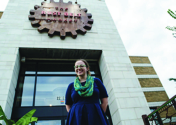 owners have provided studio space rent-free, along with a place on their roof for the antenna and tower. “Chris Best and his crew have bent over backwards to welcome us, make us feel at home and help with the various steps necessary to turn a booth into a studio. We think it’s the perfect location. Every vendor here comes from a creative, artistic, DIY background. We feel the same way.”
owners have provided studio space rent-free, along with a place on their roof for the antenna and tower. “Chris Best and his crew have bent over backwards to welcome us, make us feel at home and help with the various steps necessary to turn a booth into a studio. We think it’s the perfect location. Every vendor here comes from a creative, artistic, DIY background. We feel the same way.”
FCR is a 100-watt LPFM (short for Low Power Frequency Modulation) station, with a projected broadcast range of two miles in any direction. The FCR signal is strong and static-free all over Ferndale. LPFM stations are required to make sure their signal does not interfere with existing, mega-watt commercial stations, including one on the same frequency in Canada.
They are looking to fill DJ and other station positions. Interested volunteers should contact ferndaleradio@gmail.com.
To contribute to Ferndale Community Radio, go to: www.chuffed.org/project/ferndale-radio Sponsors are also needed, contact ferndaleradio@gmail.com.
Verndale of Ferndale – October 2017
Ferndale Radio : It’s (Almost) Here!
By David Wesley & stephanie loveless
SEVEN YEARS AFTER MICHELLE MIROWSKI LAID THE FOUNDATION for the Underwood V radio collective, and more than 20 years after free-speech activists all across the country began clamoring for access to the public airwaves…Ferndale is about to switch on the dial for our very own community radio station: 100.7 FCR FM.
The project is still in development, but as the ink dries on these pages volunteers are testing the equipment for the station. The station is expected to go live with a test signal and recorded information in the weeks ahead with a full programming schedule by Fall.
Ferndale Community Radio (FCR) is physically located inside of the Rust Belt Market at the northwest corner 9 Mile and Woodward. Owners Chris and Tiffany Best have generously offered rent-free space for the FCR broadcast studio, as well as a place on the Rust Belt roof for the essential tower and antenna.
FCR is a 100-watt LPFM (short for Low Power Frequency Modulation) station, with a projected broadcast range of perhaps two miles in any direction. We’re about to find out exactly how far FCR will reach, as soon as all the bugs get worked out. LPFM stations are required to make sure their signal does not interfere with existing, mega-watt commercial stations. Because of the congestion on the radio dial, FCR is likely to be the only LPFM station licensed in the Metro-Detroit area in the foreseeable future!
LPFM licenses are only available to community-oriented, educational, non-profit organizations. In this case, 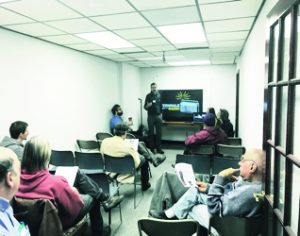 the non-profit behind FCR is Underwood V, a collective founded by Mirowski and friends. Board members include Mirowski, president; Dave Phillips, secretary/social media; Dave Kim, treasurer/promotions; Jeremy Olstyn, programming/training; and Keith Fraley, radio engineer. They are looking to fill DJ and other station positions. Interested volunteers should contact
the non-profit behind FCR is Underwood V, a collective founded by Mirowski and friends. Board members include Mirowski, president; Dave Phillips, secretary/social media; Dave Kim, treasurer/promotions; Jeremy Olstyn, programming/training; and Keith Fraley, radio engineer. They are looking to fill DJ and other station positions. Interested volunteers should contact
ferndaleradio@gmail.com.
THE MISSION OF THE STATION is to provide a kind of “hyper-local programming” that is impossible to find anywhere else on the dial. Their mission statement speaks of “community engagement, promotion of community events, specialty broadcast, and more. Potential programming for the station includes: On-air book clubs, interviews with local news-makers, coverage of government and board meetings, sports coverage,” etc.
The road to Ferndale’s first and only community radio station began over 20 years ago, when LPFM stations didn’t even exist. Ferndale Friends publisher Stephanie Loveless helped lead a national movement of democracy activists who ultimately convinced Congress and the Federal Communications Commission in 2000 to create the LPFM service, so that ordinary Americans could actually use the airwaves we already own. However, the powerful broadcast industry was able to limit the new rules so that it was impossible for even one LPFM station to go on the air in all of Metro Detroit.
However, eleven years later, President Obama signed legislation which loosened those rules enough so that it finally became possible for Metro Detroit to have one LPFM station – and it had to be in Ferndale!
So, FCR is practically a miracle. Our miracle. But it only exists because Michelle and her friends stepped up and applied for a construction permit when the FCC opened up a licensing window three years ago.
That was the easy part.
Next, they had to find a physical location for the studio, antenna and tower. And there were innumerable issues involving the City of Ferndale which had to be overcome: Not too many people walk into City Hall hoping to launch a non-profit community radio station, after all. This was brand-new territory for everyone involved. They had to find an engineer and a properly-qualified team for the construction of the tower and antenna. Negotiations with the landlord, etc.
This project would also require a significant amount of money – in fact, a little over $15,000 just to get started. So, on top of everything else, our worthy Underwood V volunteers were now charged with hustling up the cash, via social media, fundraisers, and underwriting agreements with local businesses. These fundraising efforts continue, and if you are interested in contributing, go to www.ferndaleradio.com. And local businesses are encouraged to underwrite the station financially in return for generous on-air mentions.
MANY TIMES OVER THE LAST TWO YEARS, it looked as if the money would not be found, and the whole project would have to be scrapped. But FCR supporters refused to accept defeat, and in recent weeks the decision was made to start purchasing the necessary gear: FCR is GO!
With the help of The Rust Belt and tons of local donations and support, Michelle and her team are ready to make the fresh and impactful change in radio that will nourish local talent and influence Ferndale life through the years to come.
FCR will have an impact on the Rust Belt too. Shoppers will be able to hear the station inside while they shop and will be able to meet the FCR team. It will create a more unique shopping experience.
Ferndale Community Radio will give the Ferndale residents another tool to communicate with each other. FCR has given the city something extremely unique to look forward to as it’s extremely rare that a city has their own community station!
Once they are up-and-running, they plan to partner with lots of organizations in Ferndale. For example, the schools. This will also be a great forum for local musicians from all genres to have their music heard. This will be an avenue for the creative projects that make Ferndale so noteworthy. The station will be here soon – to enrich our already vibrant and talented community.
Initial Sponsors & Underwriters
Ferndale Friends
The Rust Belt Market
Jim Shaffer & Associates
Western Market
Stange Sports
Found Sound
Crane Optical
HiLo Guy
313 Brand Co.
Save MI City : Reinvesting In Our Cities
By Sara E. Teller
MICHIGAN HAS the worst record in the nation for investing in local communities. Limiting funding at the state level greatly limits the ability of local governments to invest in the services needed to keep cities thriving. SaveMICity is an informational campaign of the Michigan Municipal League with the purpose of helping cities understand and reform municipal finance at the state level. The organization’s site boldly states, “The past is over, but we can create a new day, a new trajectory that will result in true economic growth.”
After years of working within the existing paradigms, Michigan Municipal League is undertaking a major  legislative and policy push aimed at reforming the way finances are being handled with the direct purpose of encouraging renewed investment in communities. “The theme is that local units shouldn’t just be surviving, they should be thriving,” says Sheryl Stubblefield, Finance Director for the City of Ferndale. The League will be developing policy recommendations specifically around three themes: Cost Containment, Revenue Enhancement, and Structure of Government.
legislative and policy push aimed at reforming the way finances are being handled with the direct purpose of encouraging renewed investment in communities. “The theme is that local units shouldn’t just be surviving, they should be thriving,” says Sheryl Stubblefield, Finance Director for the City of Ferndale. The League will be developing policy recommendations specifically around three themes: Cost Containment, Revenue Enhancement, and Structure of Government.
In partnership with the cities of Pleasant Ridge, Berkley, Ferndale, Oak Park, and Hazel Park, SaveMICity presentations are being conducted by the Michigan Municipal League throughout the month of August. Participants will find out why, as Michigan’s economy is recovering from the Great Recession, local communities continue to struggle financially. One of the major themes of the presentations is how Michigan has disinvested in local governments. “A major source of revenues for the local units is revenue-sharing from the state, and that continues to decline,” Stubblefield explains. Other themes include how the state is not appropriating funds to the local units, but diverting it to its own budget instead, and how the property tax system is broken. By using potential local funding for the statewide resources, local governments are left struggling.
“The way the Headlee Override and Proposal A have been set up, they are not working together,” Stubblefield claims, “The system was designed to cap tax growth, with no consideration for declines in tax revenues. There is no fix in the system for when property values dip as low as they have in the past ten years. Taxable values can only grow at the rate of inflation, as will the expenditures. There is no tool to get the taxes collected to where they were pre-recession. Local communities will never be able to catch up.”
SaveMICity presenters argue that current policies aimed at cutting costs and lowering services provided simply isn’t the answer. “As we systematically disinvest in our local communities, we are making our communities less attractive for people. If people don’t move to our communities, or as has been happening, 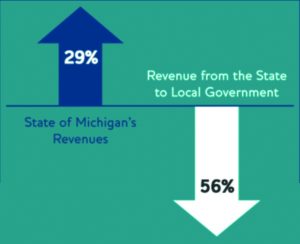 move out of our communities and out of our state, we begin this downward spiral, that will be nearly impossible to recover from,” Stubblefield explains. Basically, the less communities are able to offer residents and those visiting, the less likely they are to remain populated, and the less revenue the cities generate in the long run. It’s a vicious cycle.
move out of our communities and out of our state, we begin this downward spiral, that will be nearly impossible to recover from,” Stubblefield explains. Basically, the less communities are able to offer residents and those visiting, the less likely they are to remain populated, and the less revenue the cities generate in the long run. It’s a vicious cycle.
“We should be investing in our cities, providing communities with amenities that taxpayers are willing to support and utilize so we can create thriving communities. Increasing the tax base which will increase the tax revenues,” Stubblefield adds. If the appropriate services are provided and cities are kept desirable to live in, this will attract more residents and increase revenue. It’s a win-win.
Presenters also detail the need for tax reform at the state level. “We need informed legislators who understand the issues facing local governments and have the ability to give the local units more tools to increase investment in local communities,” says Stubblefield. The League says the answer is increasing revenues, not lowering expenditures, since local units are already operating effectively on very limited budgets. Communities need assistance from the state to continue providing desirable areas for residents to live and work. “More residents equals a higher tax base which translates to more revenues,” Stubblefield adds.
SaveMICity.com provides Michigan residents with a wealth of information regarding their local communities and the issues at hand. Inquiring minds are able to see just how much the state has taken from their specific locales via a revenue-sharing database. Sharing this information online and spreading the news to family and friends will help get the word out. “Information is power. The more people understand the process, the more involved they can become. The more legislators understand the challenges at the local level, hopefully the more involved they can become, helping foster the changes at the state level that are needed,” Stubblefield explains.
On the organization’s site, SaveMICity supporters encourage residents to “ask your legislator to rethink budget priorities and stay engaged on the broader issue of reforming our system.” The more support is garnered for initiatives designed to invest in communities for sustainable change, the more likely these changes will be made. SaveMICity is also looking for community members to help host future events. “We are taking this approach to break away from the historically limiting tactic of incremental change within the context of where we are today. We need new ideas, innovative approaches, and bold action to create a new future for communities around Michigan,” the site explains.
Sheryl says the message will be a “a continuous conversation until local units can get some relief by way of tax reform.” “By employing community-based placemaking strategies, we strengthen both our economic and social future.”

